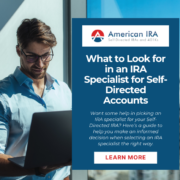Advantages of Self-Directed IRA Investing
Doing at least part of your long-term investing using a Self-Directed IRA has a number of important advantages:
Opportunity for diversification. Most off-the-shelf retirement plans offered by Wall Street investment companies do not provide a way for you to access anything beyond stocks, bonds, funds and cash products. Some may offer annuities, but they are all run-of-the-mill financial products that generate a commission or income stream for the investment company.
A Self-Directed IRA lets you hold any of the above conventional retirement account asset classes, if you choose, but also lets you add a variety of alternative asset classes to your retirement portfolio:
- Direct ownership of real estate
- Tax liens and certificates
- Private lending
- Certain gold coins and bullion
- Closely-held C corporations, partnerships and LLCs
- Farms and ranches
- Lumber
- Oil, gas and minerals.
- Mortgage notes
- Promissory notes and debentures
- Private equity
- Private debt placements
- Venture capital
- Angel investing
And much more. Each of these different types of assets can help you improve the risk-adjusted return potential of your portfolio.
Including alternative asset classes like these in your retirement portfolio is particularly effective since the correlation between these investments and the general stock or bond market tends to be relatively low.
Tax advantages of Self-Directed IRAs
If you choose a traditional Self-Directed IRA, or another tax-deferred vehicle that allows you to self-direct, such as a Self-Directed Solo 401(K), Self-Directed SEP IRA, Self-Directed SIMPLE IRA, Self-Directed CESA or even a Self-Directed HSA, your contributions are generally pre-tax, provided you meet certain income limits and requirements, and they grow tax-deferred until you take them out – normally in retirement.
If you choose a Self-Directed Roth IRA, or if you contribute to a Roth account within a Self-Directed 401(K), your contributions are after tax, but they grow tax-free, and you can take distributions in retirement both tax and penalty-free after age 59½, provided you kept the assets in your Roth account for at least five years.
Asset protection
Federal law and most state laws provide significant asset protection benefits to IRAs, including Self-Directed IRAs. This also extends to Self-Directed Solo 401(K)s, Self-Directed SEP IRAs and other forms of retirement accounts serviced by American IRA, LLC.
Courts generally protect assets in Self-Directed IRAs and other retirement accounts against the claims of creditors in lawsuits and in bankruptcy proceedings – especially if you fund the Self-Directed IRAs and other retirement accounts with your own money, as opposed to an IRA you inherited. This means if you file bankruptcy, creditors will generally not be able to place claims on your retirement accounts.
Specifics vary by state, so speak with an attorney licensed in your state for details.
Intergenerational planning
With careful planning, investors can use Self-Directed IRAs and 401(K) plans to pass assets on to future generations with very significant tax advantages, including the ability to “stretch” tax free Roth IRA or Roth 401(K) growth over the entire lifetime of a very young heir – an extremely important financial tax advantages, particularly if the heir has many decades of life expectancy in front of him or her.
Interested in learning more about Self-Directed IRAs? Contact American IRA, LLC at 866-7500-IRA (472) for a free consultation. Download our free guides or visit us online at www.AmericanIRA.com.







